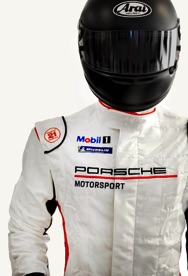The Fire Suit
Published in the August 2023 issue of “Die Porsche Kassette”

If you’re attending a Driver Education event at your local track in your Porsche sports car or SUV you probably won’t have the need for a fire suit, unless you’re driving a racecar in which case, even if not required by the Club or the Track, it is a wise choice.
If you are a PCA Club Racer, you are required to don one when on the track.
Under the Driver Requirements section of the 2023 PCA Club Racing Rules, bullet point #4 states:
4.- A one-piece approved fire retardant driving suit which meets or exceeds SFI 3.2A/5 or FIA 8856-2000 or 2018 or their successors is required. The suit may meet SFI 3.2A/1 if fire retardant long underwear is also worn. The display of the PCA Club Racing patch on the driving suit at every PCA is strongly encouraged. Driving shoes and gloves meeting SFI 3.3/5 or FIA 8856-2000 or 2018 or their successors are required. Fire retardant sox are required. Drivers with mustaches, beards or long hair extending below the helmet must wear a fire retardant balaclava.
But what exactly do the SFI or FIA specifications mean?
The two major worldwide entities that administer the standards of safety for protective gear worn by racers are The SFI Foundation (SFI) and The Federation Internationale de l’Automobile (FIA) under it’s Driver’s Section. For the most part both entities have very similar safety targets and require that safety gear worn by the drivers protect them from heat and flame when in automobile competitions. These standards concern outer garments, undergarments, socks, gloves, shoes and balaclava hoods, but not helmets. (Helmet safety standards are managed by: The Snell Foundation (which we discussed in previous articles).
Stay safe. Wear your fire suit!
For more information on fire suits and more, please visit my weibsite: www PedrosGarage.com.
Happy Porsche'ing,
Pedro
Ⓒ2023 Technolab / PedrosGarage.com
The creation of auto racing fire suits follows a meticulous process that combines advanced materials, craftsmanship, and stringent quality control measures. These specialized safety garments are not only designed to protect drivers from the intense heat and potential hazards on the track but also to provide them with peace of mind.
Material selection: The first and foremost consideration is safety so manufacturers opt for specialized flame-resistant fabrics such as Nomex, Kevlar and carbon fiber blends. These fabrics possess exceptional fire-retardant properties, allowing drivers precious seconds to escape a burning vehicle and minimizing the risk of serious injuries.
Pattern Design and Cutting: Once a suitable fabric is chosen, the next step involves pattern design and cutting. Highly skilled pattern makers create intricate designs that cater to the specific needs of drivers, ensuring a snug and comfortable fit. These patterns are then carefully laid out on the fabric, and with precision cutting techniques, the individual pieces that will form the suit are crafted.
Assembly and Stitching: The cut fabric pieces are now ready for assembly. Experienced seamstresses and tailors skillfully sew the various components together, using heat-resistant and fire-retardant threads. The stitching process requires meticulous attention to detail, ensuring the integrity and strength of the fire suit.
Reinforcement and Layering: To enhance protection, certain areas of the fire suit, such as elbows, knees and shoulders, undergo additional reinforcement. Reinforcement materials like Kevlar patches or carbon fiber inserts are carefully integrated into these high-wear zones, ensuring enhanced durability and resistance to abrasion.
Closure Systems and Customization: Fire suits employ innovative closure systems, such as high-quality zippers and Velcro fasteners, which provide a secure fit while allowing for quick removal if needed. Additionally, manufacturers often accommodate customization requests from drivers, including the incorporation of sponsor logos, team colors and personalized patches and embroidery, which adds a touch of individuality to the suits.
Quality Control and Testing: Manufacturers follow strict quality control protocols throughout the production process. Multiple inspections are conducted to ensure that the fire suits meet rigorous safety standards. Additionally, various tests are performed to evaluate their flame resistance, heat insulation, and durability. These tests simulate extreme racing conditions, validating the reliability and performance of the suits.
One of my first articles dealt with the safety helmet.
Some years after that I revised it to make it up-to-date but I never wrote about the driver’s fire suit.




Testing a suit's fire protection at the lab, on a sensor-equipped dummy
These are the specific parameters and requirements for SFI 3.2/A5:
1.- Flame Resistance: The material(s) used in the construction of the suit must be inherently flame-resistant and must meet or exceed the specific flame propagation and afterflame time requirements.
2.- Thermal Protection: The fire suit must minimize the transfer of heat and protect against burns in case of exposure to intense heat and or flames. TPP (Thermal Protective Performance): SFI 3.2/A5 fire suits must achieve a minimum TPP of 20. TPP Measures the ability of the fabric to insulate against heat transfer and indicates the time it takes for the heat to penetrate through the material.
3.- Construction and Stitching: The fire suit must be constructed using high-quality flame-resistant materials and sewn with fire-retardant thread. The stitching should be strong and secure to maintaining the integrity of the suit during racing conditions. Customization options such as sponsor logos and personalization may be available while still meeting the required standards.
4.- Certification and Compliance: SFI 3.2/A5 fire suits must be certified by the Safety Equipment Institute and comply with all of the relevant regulations and standards.
It’s important to note that the SFI 3.2/A5 rating is just one of several SFI standards for auto racing fire suits, each with its own specific parameters and requirements. These standards are continuously updated to endure the highest level of safety for auto racing drivers.
Similar to what we described above, there are standards and requirements for driving gloves, driving shoes, balaclava hoods and underwear garments. These are covered under SFI 3.3/5.
While racing suits are most commonly identified by their SFI or FIA rating, the TPP rating is the best measure of particular racing suit’s protection level. TPP is an indication of how long a suit will protect you before you would incur a second degree burn. The TPP rating is divided in half to determine the number of seconds until human tissue reaches a second degree burn. For example, if a particular fabric has a TPP rating of 35, it takes 17.5 seconds until a second degree burn occurs in a flashover situation.

In the past, racing suits were classified as single-layer and multi-layer and that determined the TPP, but in today’s world there are some single-layer suits that attain a higher TPP than some multi-layer ones. The easiest and best way to increase your driving suit’s TPP is to wear fire-retardant underwear under your suit.
Finally, proof that fire suits do a great job of protecting drivers, just look at the inferno where Romain Grosjean escaped from at the 2020 Bahrain F1 Grand Prix.
He was trapped in his car for 28 seconds before escaping.
He had to break the headrest with his helmet and pull hard with his trapped foot to remove it from the chassis.
He was transported to the hospital and was treated for second degree burns on his hands and ankles.



